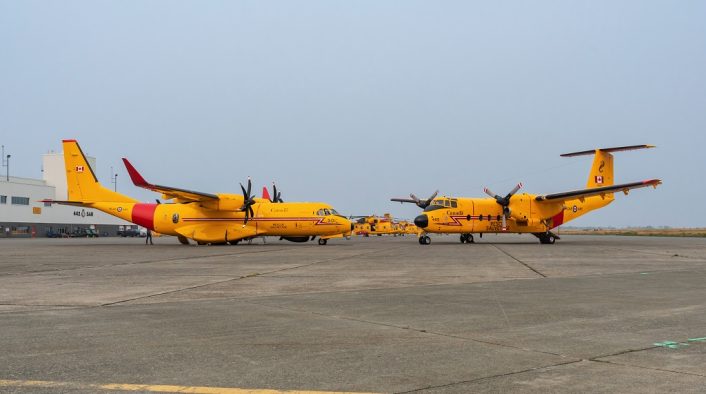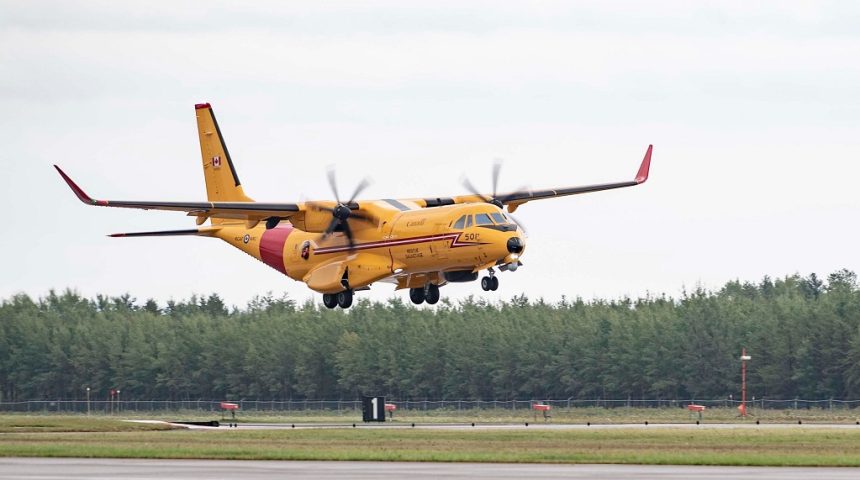The CC-295 Will Replace The CC-115 Buffalo And CC-130H Hercules Currently Used For SAR
The Royal Canadian Air Force received on September 25 the new CC-295W Kingfisher, as the Airbus C295W is locally designated, at CFB Comox (British Columbia), where the RCAF will perform aircrew training and operational testing. The new aircraft will replace the CC-115 Buffalo and the CC-130H Hercules that are currently used in a fixed wing Search And Rescue (SAR) role. This first aircraft, with tail number 501, was formally accepted by Canada in Spain in December 2019.
The RCAF provided in the press release a reason for the name that was adopted for the CC-295: “Within the First Nations of the Northwest, the kingfisher has long been recognized for its speed and agility, as well as its keen searching and hunting skills. Found all across Canada, the kingfisher well represents the abilities of our own search and rescue crews to accomplish their lifesaving role.”
Upon the delivery, Lieutenant-General Al Meinzinger, Commander of the Royal Canadian Air Force, said: “The selfless dedication of our aviators and the search and rescue services they provide to Canadians brings great credit to the Royal Canadian Air Force and the Canadian Armed Forces. The transition to the new fixed-wing search and rescue fleet is a tremendous opportunity for us and one that we take on with determination and pride.”
The CC-295 is based on the C295W, improved variant of the C295 that also features winglets, increasing payload, range and safety margins over the mountainous terrain while also reducing fuel consumption. Special provisions were made for specific features requested by Canada, like the Collins Aerospace Pro Line Fusion avionics, reinforcements to the lower rear fuselage to improve ditching operations and the addition of an upper escape hatch for a rapid aircraft evacuation if the aircraft is ditched in the ocean, a full enclosure for the main landing gear and vortex generators on the rear ramp to reduce the aerodynamic drag, improve the time-on-station and increase the top speed. The aircraft has also provisions to allow operations from unprepared runways.

The mission equipment includes a multi-mode search radar with a max range of 200 nm, capable of tracking more than 100 contacts, an Electro-Optical/InfraRed (EO/IR) turret with multi-spectral imaging, Automatic Identification System (AIS) to identify and locate ships, aircraft, land bases and navigational aids equipped with AIS transponders, two onboard operator stations and large bubble windows for observation. The integrated sensors suit will allow crews, according to the RCAF, to locate persons or objects from more than 40 kilometers away, even in low-light conditions, while the communications suite will increase interoperability with other search and rescue assets, such as the CH-149 Cormorant.
The day of the delivery of the first CC-295 Kingfisher, Airbus posted a video of the walkaround of the aircraft, highlighting its main features. You can find the video below.
The Fixed Wing Search and Rescue Aircraft Replacement (FWSAR) contract for the CC-295, worth $2.4 billion, was awarded in December 2016, which was unexpected as the Leonardo C-27J was deemed to be the favorite contender with its greater speed, payload and range. However, Airbus won because of the cost, which “was worth 25 of 100 points in the evaluation process”.
After the first CC-295 rolled off the assembly lines in October 2019, at the beginning of this year the RCAF received an Aircraft Maintenance Trainer (AMT) that was flown to Comox, disassembled and then reassembled inside the new SAR training center. This aircraft is not part of the 16 CC-295s included in the FWSAR contract, as it is not equipped to conduct operational SAR missions. In the meanwhile, other two aircraft have been formally accepted in Spain, while a fourth one is undergoing testing and evaluation.
Look at those shiny new planes! ✈️ Canada just accepted the 2nd and 3rd CC-295 in Spain 🇪🇸, bringing us one (and two) step(s) closer to replacing our #FWSAR aircraft. pic.twitter.com/RkRm7N4DU1
— Canadian Armed Forces (@CanadianForces) August 7, 2020
I really like the picture of our Aerial Delivery tests for the #C295 #FWSAR program 😎Programme is on the right path towards its full operational deployment on Canadian soil for future Search&Rescue missions.#AIRBUS #Defence & #Space #Canada pic.twitter.com/bXps1kthd8
— Dirk Hoke (@HokeDirk) July 24, 2020
The RCAF will operate the new fixed-wing fleet from 19 Wing Comox, 17 Wing Winnipeg (Manitoba), 8 Wing Trenton (Ontario), and 14 Wing Greenwood (Nova Scotia). Each location will receive three aircraft, with Comox also receiving two additional airframes, for a total of five, as it hosts the SAR training center. The two remaining aircraft will be positioned as required to support operations.
After the arrival of the first aircraft, the RCAF is planning to open the training center next year, reaching the Initial Operational Capability in 2022, when the deliveries will be completed. During the transition period, fixed-wing search and rescue missions will continue through the existing CC-115 and CC-130H fleets, along with the CH-149 Cormorant and CH-146 Griffon helicopters.









